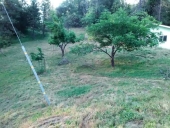I've got the same problem. The only sunny and cleared hillside within a reasonable distance from the house is what we call septic hill...because that's where the septic field is located. The cleared slope area measures about 75 feet by 50 feet with the septic area taking up about 1/3-1/2 of that space. I haven't measured it accurately yet.
We've flattened the very top of the area where the tree line is and are building our coop and run there. There is room for a couple terraces between the coop and the top of the septic area. One will be pathway, one will be growing space. The terraces will be roughly on contour going around the septic with the septic area getting a 2-foot tall fence and planted with shallow rooted flowers and grasses that will self-seed.
The bottom terrace follows the line of the existing access road and consists of a lot of dirt that has been dug out and moved back up the hill in order to widen the road for easier vehicle access to animal buildings. Once we get this in place, we'll be backfilling it with the existing soil and working the uphill terraces from there. Laying the block wall then backfilling with excess soil from elsewhere on the property - cutting into the hillside as little as possible.
For the terrace walls I'm using the retaining wall blocks with the built-in set-back...all made by hand to cut down on costs. I would love to have used existing rocks but I wanted the more secure stability of the pre-formed blocks and while there are plenty of rocks in my soil, it's mostly clay. As I get the terraces built, I'll be adding partially composted bedding from the coop and barn which consists of a mix of manure, hay, straw, pine shavings and leaf litter. I'm hoping the soil will greatly improve over the next few years.
We tried digging swales our first year here and after a LOT of work and watching the swales fill with water during the rains, our crops still didn't do well so I got the idea that the terraces would do better overall. Plus, we'll be able to hook up a water harvesting/irrigation system to the house roof that we can use to water if necessary.








